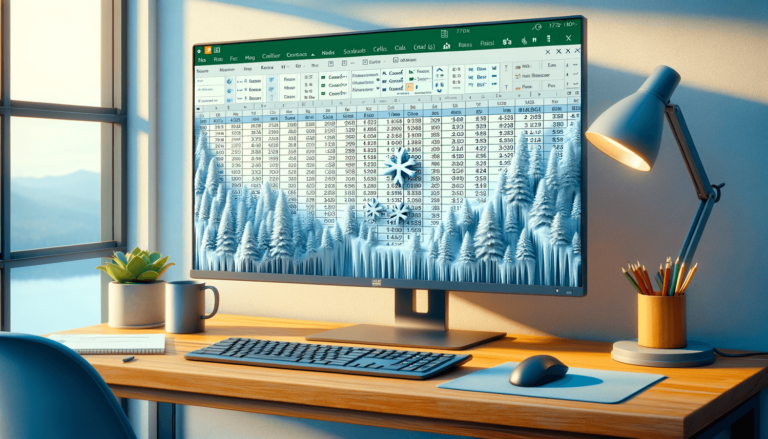

Microsoft Excel is a powerful data management tool that offers diverse functionalities for organizing and analyzing data in a tabular format. When working on large spreadsheets with many rows and columns, it’s common to lose track of the column headings as we scroll down. To avoid this, we can freeze the header row so that it remains visible and accessible as we navigate through the rest of the sheet. In this blog post, we will explore how to freeze header in Excel, and get familiar with the primary tools and techniques you need to use to achieve this task.
Microsoft Excel is an advanced spreadsheet program that offers various powerful tools for managing, analyzing and manipulating data in a tabular format. In large spreadsheets with many rows and columns, it’s quite easy to get lost or confused, especially if you have to scroll down frequently to find the required information.
In such scenarios, freezing header rows can be immensely helpful. The header row contains column headings that help remember the context of each column. When you scroll down, the header row disappears, and you lose track of which column you’re looking at. Freezing the header row means that it stays visible, even when you scroll down the sheet, which makes it easier for you to work.
Firstly, select the row below the row you want to freeze. For instance, if the header row is in row 1, you should select row 2. You can select the entire row by clicking the row number on the left side of the screen, or simply clicking the first cell of that row.

Next, open the ‘View’ tab located in the ribbon on the top of the screen.

Under the ‘View’ tab, there is a ‘Freeze Panes’ button that contains several options. From the menu, you will see three options: ‘Freeze Top Row’, ‘Freeze First Column’ and ‘Freeze Panes’. Choose ‘Freeze Panes’.

Now that you have frozen the header row, scroll down through the spreadsheet and ensure that the heading row remains visible even when the rest of the sheet moves. You can now navigate to different areas of your sheet, providing you with quick access to column headings.
Congratulations! You’ve just successfully learned how to freeze header in Excel. This technique can be used in different spreadsheets to make your work easier and organized. If you frequently work with large datasets in Microsoft Excel, freezing the header row can save you a lot of time and trouble. It’s a simple yet impactful trick that can be instantly implemented into your work routine, ensuring that your Excel data is easy to navigate and manage.
In addition to freezing the header row to make it remain visible, Excel offers several other setting modifications that can be applied to header rows. Below are a few other Excel header-related tips and tricks that you might find helpful:
If, at any time, you want to unfreeze the header row, follow the steps below:
Just like freezing rows, you can also freeze columns in Excel to make them remain visible as you scroll horizontally. Follow the steps below to freeze columns:
If you have a long Excel sheet of data that you want to filter, Excel offers a helpful trick of using the header row as filters. Follow these steps to do this:
Freezing header rows in Excel is a simple but powerful tool that helps you to navigate your data more efficiently. It is especially helpful for large spreadsheets where you need to keep track of column headers as you scroll down. To freeze the header row, follow the steps outlined in this article. Additionally, you can unfreeze the header row, freeze columns, or even use header cells as filters to make your data management even more efficient. With these tips and tricks, you’re well on your way to becoming an expert in Excel header management.
Here are some frequently asked questions related to freezing header rows in Excel:
Yes, you can freeze more than one row in Excel. To do this, select the row below the last row you want to freeze. Then go to the ‘View’ tab, click the ‘Freeze Panes’ dropdown, and select ‘Freeze Panes’.
Yes, you can. To change the frozen header row’s size, put your cursor on the row’s boundary (the line that separates rows) and drag it up or down to your desired size.
To unfreeze rows in Excel, go back to the ‘View’ tab, click the ‘Freeze Panes’ dropdown, and select ‘Unfreeze Panes’. This will remove the frozen pane.
Yes, you can freeze columns to keep them visible as you scroll horizontally through your sheet. Select the column to the right of the column(s) you want to freeze. Then, from the ‘View’ tab, click the ‘Freeze Panes’ dropdown, and select ‘Freeze Panes’.
You can use the header cells as filters in Excel. To do this, select the data range, including the header row, then go to the ‘Data’ tab and click on the ‘Filter’ button. Excel will add the filter icon to the right side of each header cell that can be used to filter data.
Explore the world of Microsoft PowerPoint with LearnPowerpoint.io, where we provide tailored tutorials and valuable tips to transform your presentation skills and clarify PowerPoint for enthusiasts and professionals alike.

Your ultimate guide to mastering Microsoft Word! Dive into our extensive collection of tutorials and tips designed to make Word simple and effective for users of all skill levels.

Boost your brand's online presence with Resultris Content Marketing Subscriptions. Enjoy high-quality, on-demand content marketing services to grow your business.
